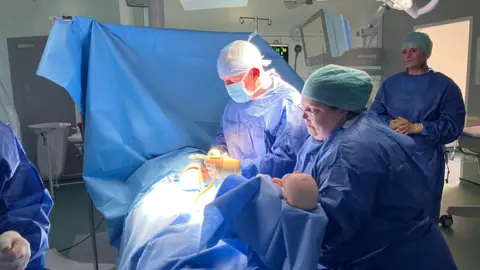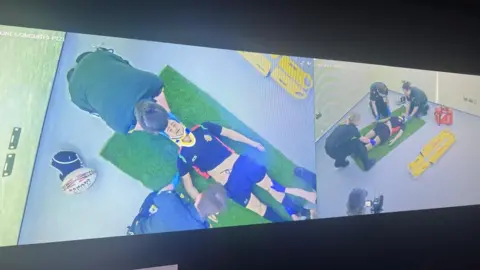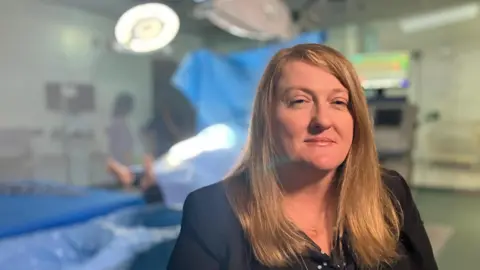The talking dolls training up the NHS medics of the future
 BBC
BBCStudent nurses Tracy, Briall and Misha are assessing Aria, a seven-year-old girl with pneumonia.
Aria tells them she does not know what is going on, explains how frightened she is and asks: "Where's mummy?"
But none of this is real.
Aria is a high-tech manikin who forms part of a training exercise in one of several simulation rooms at Swansea University's Simulation and Immersive Learning Centre (SUSIM), one of the biggest and most advanced healthcare simulation centres in the world.
The students who train here, including future nurses, doctors, and midwives, say the environment is so realistic that they often forget it isn't reality.
"[Aria] is built like a child, reacts like a child and has needs like a child," said nursing student Tracy Qui. "She's also scared like a child."
Just down the corridor, a surgical team is preparing to bring a new baby into the world.
Lights flash, monitors beep and staff dash around the labour ward.
"I'm just waiting for baby to cry," said the midwife, as it is delivered by C-section. "Then I'll be happy."
After a few vital checks, mother and baby are reunited for their first skin-to-skin contact.
"Congratulations mum," said the midwife. There are broad smiles all around.
But mother and baby, in this scenario, are also high-tech manikins.

The room is kitted out with the instruments and machines you would find in a real operating theatre.
Even the smells of an operating theatre are piped in, while video images from a real hospital are projected onto the walls.
"You get so immersed in it - you forget you're not out in real practice," said student midwife Kellie Mills.
"This is a real baby in our hands and we're very protective of it."
'They can even smell the grass'
The scale of the centre means it can simulate many different scenarios.
In another simulation room, student paramedics Jojo, Rhys and Sophie are tending to a rugby player injured on a pitch.
"Me and the crew have come in and immobilised his spine, and to make sure there are no further injuries we're using a collar," said first year student Jojo Bratt-Ward.
But they are trying to do this while other rugby players run around them with the crowd chanting and singing in the surrounding stands.
"They can even smell the grass," said Gareth Chilcott, the technician who is running the simulation from a neighbouring room.

"As soon as they enter they realise they are on a rugby pitch," he added.
"We can also lower the temperature so that it's cold and they feel they're running into the wind. It really does heighten their senses."
Lecturers who supervise the simulation can also throw in some surprises to the scenario based on the student's level of experience.
"They really enjoy it and almost see it as a bit of fun," said senior paramedic lecturer Jason Sadler.
"But when they go on placement [with the ambulance service] and come back and tell us what they had to deal with, they can really appreciate the benefits of what we put them through."
'Limitless possibilities'
From hospital wards and care homes to medical emergencies in cafes or nightclubs, staff say there are no limits on what can be simulated at the facility in Swansea.
They can even replicate healthcare settings in other countries, as happened in a recent collaboration with workers in Zambia.
"A lot of what we project on the walls is filmed within our local NHS but we could equally film in any country in the world," said Prof Jayne Cutter, head of the university's school of health and social care.
"So if we're entertaining international students, they could practice in environments that are familiar to them."
The £7m facility was developed by converting a teaching block at Swansea's Singleton Park campus and establishing a second smaller site in Carmarthen.
Both centres are linked digitally, so everything that's happening in one can be seen in the other.
"We have the largest installation of immersive wall technology globally and the second largest simulation management system in Europe," said Joanne Davies, the university's head of simulation education.

"I know other centres in the UK and internationally tend to have one or two of these rooms. We have 11, which means we can do mass training not only for our core students but also NHS staff and industry."
Staff said the main aim of SUSIM was not to replace the real world experiences students must have before they qualify, but to supplement them.
They said some students could get overwhelmed when they first experienced a real operating theatre or busy ward.
"If you're not immersed in realistic surroundings you can get overloaded, what's known as cognitive overload. And sometimes when we're stressed we can even forget our own name," said Ms Davies.
"But here we have the sights, the sounds, the smells of realistic environments and that helps our students remember what they've learnt and transfer that into practice."
Another benefit, according to the students, is that they can learn from their mistakes without fear of causing harm.
"We have pre-briefs and debriefs. We talk about what we've learnt," said student midwife Kellie Mills.
"But we have a phrase here - what happens in SUSIM stays in SUSIM - so it really is a protected environment."
